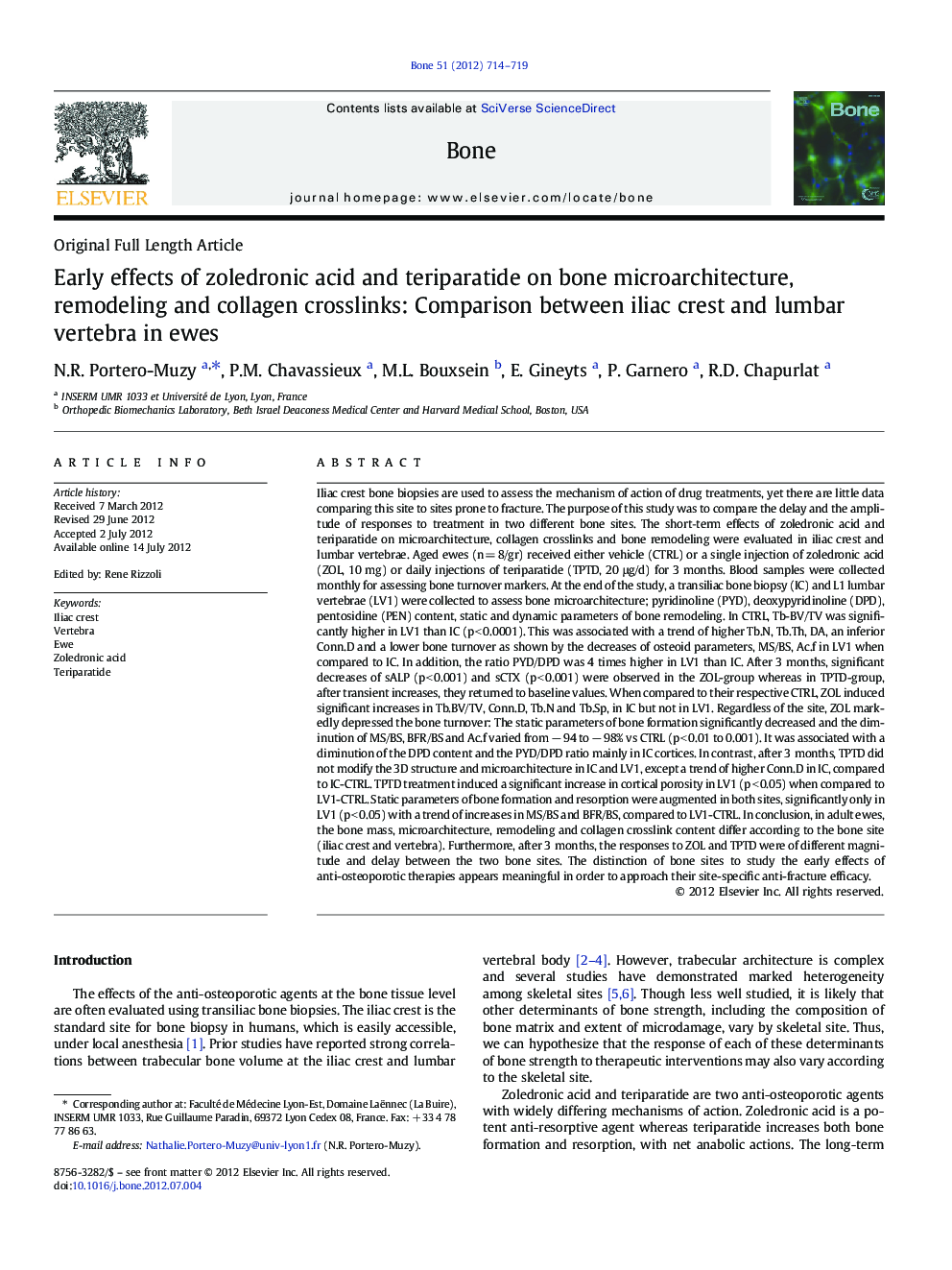| کد مقاله | کد نشریه | سال انتشار | مقاله انگلیسی | نسخه تمام متن |
|---|---|---|---|---|
| 2779399 | 1153272 | 2012 | 6 صفحه PDF | دانلود رایگان |

Iliac crest bone biopsies are used to assess the mechanism of action of drug treatments, yet there are little data comparing this site to sites prone to fracture. The purpose of this study was to compare the delay and the amplitude of responses to treatment in two different bone sites. The short‐term effects of zoledronic acid and teriparatide on microarchitecture, collagen crosslinks and bone remodeling were evaluated in iliac crest and lumbar vertebrae. Aged ewes (n = 8/gr) received either vehicle (CTRL) or a single injection of zoledronic acid (ZOL, 10 mg) or daily injections of teriparatide (TPTD, 20 μg/d) for 3 months. Blood samples were collected monthly for assessing bone turnover markers. At the end of the study, a transiliac bone biopsy (IC) and L1 lumbar vertebrae (LV1) were collected to assess bone microarchitecture; pyridinoline (PYD), deoxypyridinoline (DPD), pentosidine (PEN) content, static and dynamic parameters of bone remodeling. In CTRL, Tb-BV/TV was significantly higher in LV1 than IC (p < 0.0001). This was associated with a trend of higher Tb.N, Tb.Th, DA, an inferior Conn.D and a lower bone turnover as shown by the decreases of osteoid parameters, MS/BS, Ac.f in LV1 when compared to IC. In addition, the ratio PYD/DPD was 4 times higher in LV1 than IC. After 3 months, significant decreases of sALP (p < 0.001) and sCTX (p < 0.001) were observed in the ZOL-group whereas in TPTD-group, after transient increases, they returned to baseline values. When compared to their respective CTRL, ZOL induced significant increases in Tb.BV/TV, Conn.D, Tb.N and Tb.Sp, in IC but not in LV1. Regardless of the site, ZOL markedly depressed the bone turnover: The static parameters of bone formation significantly decreased and the diminution of MS/BS, BFR/BS and Ac.f varied from − 94 to − 98% vs CTRL (p < 0.01 to 0.001). It was associated with a diminution of the DPD content and the PYD/DPD ratio mainly in IC cortices. In contrast, after 3 months, TPTD did not modify the 3D structure and microarchitecture in IC and LV1, except a trend of higher Conn.D in IC, compared to IC-CTRL. TPTD treatment induced a significant increase in cortical porosity in LV1 (p < 0.05) when compared to LV1-CTRL. Static parameters of bone formation and resorption were augmented in both sites, significantly only in LV1 (p < 0.05) with a trend of increases in MS/BS and BFR/BS, compared to LV1-CTRL. In conclusion, in adult ewes, the bone mass, microarchitecture, remodeling and collagen crosslink content differ according to the bone site (iliac crest and vertebra). Furthermore, after 3 months, the responses to ZOL and TPTD were of different magnitude and delay between the two bone sites. The distinction of bone sites to study the early effects of anti-osteoporotic therapies appears meaningful in order to approach their site-specific anti-fracture efficacy.
► We observe two different bone sites in ewes.
► We compare microarchitecture, remodeling and collagen crosslink content in ewe bone after a short-term treatment with zoledronate acid or teriparatide.
► To fully understand the anti-fracture efficacy of osteoporosis therapies different skeletal sites should be examined.
Journal: Bone - Volume 51, Issue 4, October 2012, Pages 714–719